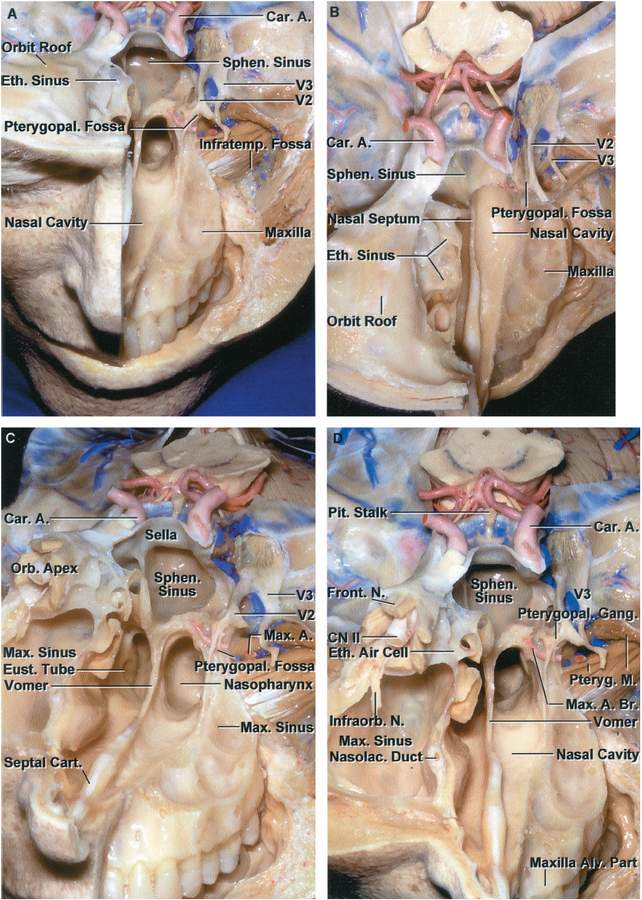Anterior and Middle Cranial Base
6066
Surgical Correlation
Tags
A, On the left side, the floor of the anterior fossa and the upper portion of the maxilla have been removed to expose the structures deep to the anterior and middle cranial fossa. The frontal, ethmoidal, and sphenoid sinuses and the nasal cavity lie below the medial part of the anterior cranial base. The orbit and maxilla are located below the lateral part of the anterior cranial base. The sphenoid sinus and sella are located in the medial part of the middle cranial base, and the infratemporal and pterygopalatine fossa are located below the lateral part of the middle cranial base. The carotid arteries pass upward on the medial part of the middle cranial base and are intimately related to the sphenoid and cavernous sinuses. The infratemporal fossa, which contains branches of the mandibular nerve, pterygoid muscles, pterygoid venous plexus, and maxillary artery, is located below the middle cranial base and greater sphenoid wing. The alveolar process of the maxilla, which encloses the roots of the upper teeth, has been preserved on the left side. The maxillary nerve enters the pterygopalatine fossa, which is located medial to the infratemporal fossa between the posterior wall of the maxilla and the pterygoid process of the sphenoid bone. B, Superior view of the anterior and middle cranial base. The infratemporal fossa is located posterolateral to the maxilla. The right ethmoid air cells are exposed on the medial side of the right orbit. The nasal cavity extends upward between the ethmoidal sinuses. C, Oblique anterior view. The facial structures on the right side have been removed to expose the orbital apex located above the maxillary sinus. The walls of the right maxillary sinus form the floor of the orbit, much of the lateral wall of the nasal cavity, and the anterior wall of the pterygopalatine and infratemporal fossa. On the left side, the mandibular nerve enters the infratemporal fossa. The maxillary nerve enters the pterygopalatine fossa, which is located in the lateral wall of the nasal cavity and contains the maxillary nerve, pterygopalatine ganglion, and terminal branches of the maxillary artery. D, Anterior view. The orbital apex is located above the pterygopalatine fossa. The frontal branch of the ophthalmic nerve passes along the roof of the orbit, and the infraorbital branch of the maxillary nerve courses in the floor of the orbit. The posterior ethmoid air cells are located medial to the orbital apex. The vomer forms the posterior part of the nasal septum and attaches to the maxilla and palatine bones below and to the body of the sphenoid bone above. The sphenoid sinus is located in the middle cranial base below the sella turcica. The upper brainstem is seen in the posterior part of the exposure. (Images courtesy of AL Rhoton, Jr.)




